| Botanical Name |
Ehretia rigida subsp. rigida |
| Family |
Boraginaceae - The forget-me-not family. |
| Pronunciation |
|
| Common Name(s) |
English: Puzzle bush; Cape Lilac
Afrikaans: Deurmekaarbos; Bergwitboom
IsiXhosa: iBotshane; Umhleli
|
| Plant Group |
- Shrub A woody plant of relatively low height, having several stems arising from the base and lacking a single trunk; a bush.
|
| Plant Size |
- Very large
| Tree | Over 25m |
| Shrub | Over 4m |
| Perennial/ground cover | Over 1m |
| Bulb | Over 1.2m |
| Succulent | 1.5m to 2m |
- Medium to Large
| Tree | 15m to 20m |
| Shrub | 2m to 3m |
| Perennial/ground cover | 60cm to 75cm |
| Bulb | 60cm to 1m |
| Succulent | 60cm to 1m |
|
| Position |
- Dry Shade Shady areas where soil has poor water retention or are dependent on rain for their moisture needs.
- Partial Shade The area is in shade for part of the day and in full sun for part of the day.
- Sun The area is in full sun for all or most of the day, all year round.
|
| General Information |
- Attractive fruits, berries or seeds Brightly coloured fruits or berries increase and extend the visual impact of the plant and are especially attractive to birds and other small wildlife.
- Drought Tolerance: High The plant is well adapted to arid conditions; it can survive long periods of drought and high temperatures without extra water.
- Evergreen Plants that have leaves all year round.
- Fragrant / Aromatic These plants posses a strong, usually pleasant odour.
- Frost: Hardy The plant can withstand freezing temperatures or frost without artificial protection.
- Sand tolerant Plants adapted to survive in nutrient poor, very sandy soils.
- Water Wise Plant species originating from low rainfall regions that require less water to survive and thrive than other plant species.
- Wind Tolerant Plants able to withstand the effect of strong winds.
|
| Specific Information |
Often multi-stemmed, this rather untidy, rounded shrub has haphazard, entangled, somewhat drooping branches, hence the common name 'Puzzle Bush'. The light green leaves are stiff, smooth and shiny. A 'must have' for luring wild life into the garden. and can be used as part of a barrier or hedge. Ehretia rigida tolerates some pruning but this shrub definitely has a mind of its own and is possibly best left to live up to its name without interference. The round fruits turn from orange to red and when ripe, black. They are edible but are reportedly unpleasant tasting, but the birds don't seem to mind.
|
| Ad Break |
|
| Flowers |
| Description |
small flowers in dense heads approximately 7 cm across
|
| Season |
- Spring to Autumn Plants will seldom bloom for the entire season as given in the list, but should flower during a period within these parameters.
|
| Colour |
|
| Growth Rate |
- Moderate to Fast Specifying growth rate can be very misleading as there is considerable variation of growth rate depending on type and species of plant, available water, supplementary feeding, mulching and general care, as well as the plants suitability and adaptability to the garden environment.
|
| Plant Uses |
- Attracts bees, butterflies or other insects This plant attracts insects which can be food for birds or other creatures in your garden.
- Attracts Birds This plant will attract birds.
- Barrier Plant A very thorny shrub, tree or scrambler that can be used to create an impenetrable barrier.
- Boundary A plant useful for planting around the edges of the property to form a green or colourful backdrop, an impenetrable hedge, to hide walls or create privacy.
- Container Trees, shrubs and ornamental species that can adapt to growing in a restricted environment.
- Filler Either a fast growing tree or shrub used temporarily to fill in an area while the permanent plants grow to a desired size, or a plant used to fill gaps in borders or beds.
- Hedge Suitable trees or shrubs planted relatively close together so that the branches intertwine to create a barrier. This can be formal – the plants are regularly trimmed to produce a neat shape, or informal – the plants are left to themselves to create a natural hedgerow.
- Pioneer for new gardens A very fast growing plant, able to withstand hardship, that can be used to populate land that has recently been cleared of natural vegetation. These plants pave the way for slower-growing species by adding nutrients to the soil and creating leaf litter.
- Provides light / dappled shade A tree with an open to sparse canopy, through which varying degrees of sunlight can penetrate.
- Suitable for coastal gardens Plants adapted to dry, sandy soil, forceful wind, limited rainfall and intense sunlight.
- Wild Garden An indigenous garden planted for the benefit of wildlife and birds. Provides food, water, a variety of mini-biomes and no poisonous chemicals are used.
|
| Distribution and Habitat |
throughout the eastern half of the country, as well as in Botswana, Swaziland and Lesotho, in a wide variety of habitats, from wooded grassland to karoid scrub and bushveld
|
| Planting Suggestions |
Best planted in full sun or partial shade in well drained soil to which compost has been added. Mulch well to retain moisture. In favourable conditions Ehretia rigida can grow 600 - 700 mm per year.
|
| Medicinal Uses |
Medicinally, the powdered roots are used to treat small cuts made in the skin of the chest and abdomen to relieve pain, and to treat gall sickness in cattle. Ehetia rigida is much evident in folklore. It is to said to bring luck to hunters, to weaken their prey, to calm a bad-tempered ox and to protect huts and crops from hail. Because they are strong and flexible, the branches have been used to make hunting bows and fishing baskets .
|
| Ad Break |
|


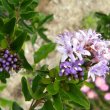
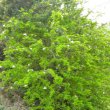
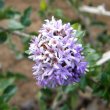
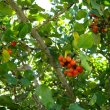
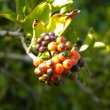
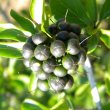
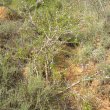


Discuss this plant
Share knowledge, ask a question or give an experience.